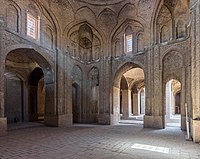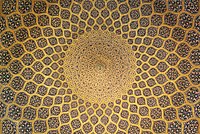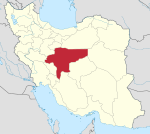world.wikisort.org - Iran
Isfahan Province (Persian: استان اصفهان, romanized: Ostāne Esfahan), also transliterated as Esfahan, Espahan, Isfahan, or Isphahan, is one of the thirty-one provinces of Iran. It is located in the center of the country in Iran's Region 2.[4] Its secretariat is located in the city of Isfahan.
Isfahan Province
استان اصفهان | |
|---|---|
Province | |
 | |
 Location of Isfahan within Iran | |
 Map | |
| Coordinates: 32.6577°N 51.6692°E | |
| Country | Iran |
| Region | Region 2 |
| Capital | Isfahan |
| Counties | 24 |
| Government | |
| • Governor-general | Reza Mortazavi |
| Area | |
| • Total | 107,018 km2 (41,320 sq mi) |
| Population (2016)[1] | |
| • Total | 5,120,850 |
| • Estimate (2020) | 5,343,000[2] |
| • Density | 48/km2 (120/sq mi) |
| Time zone | UTC+03:30 (IRST) |
| • Summer (DST) | UTC+04:30 (IRST) |
| Main language(s) | Predominantly Persian. small Minority: Bakhtiari Luri, Qashqai, Georgian, Armenian languages in some regions of the province |
| HDI (2017) | 0.830[3] very high · 3rd |
| Website | www |
| Year | Pop. | ±% |
|---|---|---|
| 1966 | 1,703,701 | — |
| 1986 | 3,294,916 | +93.4% |
| 2006 | 4,559,256 | +38.4% |
| 2011 | 4,879,312 | +7.0% |
| 2016 | 5,120,850 | +5.0% |
| amar.org.ir | ||
Geography
The Isfahan province covers an area of approximately 107,018 square km and is situated in the center of Iran. To its north, stand the Markazi (Central) Province and the provinces of Qom and Semnan. To its south, it is bordered by the provinces of Fars, and Kohgiluyeh and Boyer-Ahmad Province. Aminabad is the most southern city of Isfahan province just 2 km north of the border. To the east, it is bordered by the province of Yazd. To the west, it is bordered by the province of Lurestan and to the southwest of the province of Chahar Mahal and Bakhtiyari.
The city of Isfahan has been the provincial capital, and the counties of this province are as follows: Aran va Bidgol County, Ardestan County, Borkhar County, Buin va Miandasht County, Chadegan County, Dehaqan County, Falavarjan County, Faridan County, Fereydunshahr County, Golpayegan County, Isfahan County, Kashan County, Khansar County, Khomeyni Shahr County, Khur and Biabanak County, Lenjan County, Mobarakeh County, Nain County, Najafabad County, Natanz County, Semirom County, Shahin Shahr and Meymeh County, Shahreza County, and Tiran and Karvan County; 18 townships, 25 counties, 93 cities, and 2,470 villages in all.
According to the census in the year 2016, the population of the province was 5,120,850, of which approximately 88 percent were urban residents and 12 percent resided in the rural areas. In 2006, the literacy rate was 88.65 percent.[5] The province experiences a moderate and dry climate on the whole, ranging between 40.6 °C (105.08 °F) and 10.6 °C (51 °F) on a cold day in the winter season. The average annual temperature has been recorded as 16.7 °C (62 °F) and the annual rainfall on average has been reported as 116.9 mm. The city of Sepahan (Esfahan) however experiences an excellent climate, with four distinct seasons.
With an elevation of 4,040 metres, the Shahankuh is the highest peak in Isfahan Province. This mountain is located about 20 kilometres southwest of the city of Fereydunshahr in the western part of Isfahan Province.
Isfahan province consists of 52 rivers. They are small and temporary, with the exception of the Zāyanderud, which totals 405 km in length a basin area of 27,100 km2.[6]
Biodiversity
Aphanius isfahanensis (Farsi: کپوردندان_اصفهان) is a species of Cyprinodontid fish endemic to the Zayandehrud river basin (see genus Aphanius). It is known only from three sites across the province.[7][8][9][10] Allium chlorotepalum is an endemic species of Isfahan province, Astragalus vernaculus is also common in the west of the province.[11][12]
History and culture
Historians have recorded Espahan, Sepahan or Isfahan initially as a defense and military base. The security and protection of the gradually increasing castles and fortifications, thereby, would provide the protection of residents nearby, therefore leading to the growth of large settlements nearby. These historical castles were Atashgah, Sarooyieh, Tabarok, Kohan Dej, and Gard Dej. The oldest of these is Ghal'eh Sefeed and the grounds at Tamijan from prehistoric times. The historic village of Abyaneh, a nationwide attraction, also has Sassanid ruins and fire temples among other historical relics.
During the 17th and 18th centuries, Isfahan province enjoyed high standards of prosperity as it became the capital of Safavid Persia. While the city of Sepahan (Esfahan) was their seat of monarchical, Kashan was their place of vacation and leisure.
Isfahan province encompasses various sects today. The majority of the people in the province are Persian speakers, but Bakhtiari Lurs, Georgians, Armenians, Qashqais and Persian Jews also reside in the province. The official language of the province is Persian, though different ethnic groups and tribes speak languages of their own, including Judeo-Persian, Armenian, Georgian, Qashqai Turkic and Bakhtiari Lurish. Isfahan province is noted for the large number of cultural luminaries which it has produced, including poets, scholars, philosophers, theologians and scientists of national renown.
According to the Isfahan atlas[who?], well-known local dishes include Shefte, Kachi, Kebab Golpayegan, Samanu Shahreza, Carrot stew Khansar , Yokhe bread (Kaak) and Semirom.[13][14]
Administration
Ostandari Isfahan
Language
A majority of the population speak Persian as first language with a minority of Luri, Turkic, Georgian, Biyabanaki and Armenian speakers.[15]
Gallery
- Cultural Heritage of Iran
- Kashan is another cultural jewel of the province. Seen here is the Agha Bozorg Mosque.
Education
Public universities
- Isfahan University of Technology
- Isfahan University
- Isfahan University of Medical Sciences
- Kashan University of Medical Sciences
- Isfahan University of Art
- Malek-Ashtar University of Technology
- University of Kashan
Islamic Azad Universities
Several well-known Islamic Azad University campuses in Iran are located in the province:
- Islamic Azad University of Falavarjan[16]
- Islamic Azad University of Meymeh
- Islamic Azad University of Kashan
- Islamic Azad University of Majlesi
- Islamic Azad University of Shahreza
- Islamic Azad University of Najafabad
- Islamic Azad University of Khomeynishahr
- Islamic Azad University of Isfahan[17]
- Islamic Azad University of Khorasgan[18]

Economy
Nine tons of saffron are produced by this province by the year.[19]
It's the biggest milk and dairy producer in Iran.[20]
See also
- Georgians in Iran
- History of Iran
- List of the historical structures in the Isfahan province
- List of cities in Isfahan Province by population
References
- "National census 2016". amar.org.ir. Archived from the original on 2018-06-12. Retrieved 2017-03-14.[]
- Amar. "توجه: تفاوت در سرجمع به دليل گرد شدن ارقام به رقم هزار مي باشد. (in Persian)". Archived from the original on August 3, 2020. Retrieved September 29, 2020.
- "Sub-national HDI - Area Database - Global Data Lab". hdi.globaldatalab.org. Archived from the original on 2018-09-23. Retrieved 2018-09-13.
- "همشهری آنلاین-استانهای کشور به ۵ منطقه تقسیم شدند (Provinces were divided into 5 regions)". Hamshahri Online (in Persian). 22 June 2014 [1 Tir 1393, Jalaali]. Archived from the original on 23 June 2014.
- "Statistical Center of Iran > Population and Housing Censuses". www.amar.org.ir. Archived from the original on 2020-07-27. Retrieved 2020-11-18.
- EIr and Xavier de Planhol, “ISFAHAN i. GEOGRAPHY,” Encyclopaedia Iranica, 2012. Archived 2020-05-26 at the Wayback Machine.
- Ghafouri, Zaniar; Keivany, Yazdan; Soofiani, Nasrollah M. (2019-01-01). "Reproductive biology of Aphanius isfahanensis in the Zayandehrud River, central Iran". Environmental Biology of Fishes. 102 (1): 19–25. doi:10.1007/s10641-018-0833-0. ISSN 1573-5133. S2CID 53816219. Archived from the original on 2020-12-20. Retrieved 2020-09-29.
- Zicha, Ondrej. "BioLib: Biological library". www.biolib.cz. Archived from the original on 2016-03-04. Retrieved 2020-09-27.
- زانيار, غفوري; يزدان, کيواني; نصراله, محبوبي صوفياني (March 21, 2018). "شاخص هاي تغذيه اي کپوردندان ماهي اصفهان (Aphanius isfahanensis) در رودخانه زاينده رود در ايران" (in Persian). 5 (3): 184–191. Archived from the original on 2020-12-20. Retrieved 2020-09-29.
{{cite journal}}: Cite journal requires|journal=(help) - "تنوع جمعیتی کپوردندان اصفهان (aphanius isfahanensis)". www.virascience.com. Archived from the original on 2020-12-20. Retrieved 2020-09-27.
- اخوان روفیگر, آزاده; باقری, علی; جمزاد, زیبا; جلیلی, عادل (2019). "The conservation status of two Allium )Amaryllidaceae( species in Iran". طبیعت ایران. 4 (1). doi:10.22092/irn.2019.118682. Archived from the original on 2020-12-20. Retrieved 2020-10-06.
- اخوان روفیگر, آزاده; باقری, علی; جم زاد, زیبا; جلیلی, عادل (2020). "Conservation status of endemic species Astragalus vernaculus (Fabaceae)". طبیعت ایران. 4 (6). doi:10.22092/irn.2020.120810. Archived from the original on 2020-10-08. Retrieved 2020-10-06.
- "آغاز تدوین اطلس غذایی استان اصفهان". www.iribnews.ir. Archived from the original on 2020-12-20. Retrieved 2020-12-20.
- "تدوین اطلس غذایی استان اصفهان آغاز شد- اخبار اصفهان - اخبار استانها تسنیم - Tasnim". خبرگزاری تسنیم - Tasnim (in Persian). Archived from the original on 2020-12-20. Retrieved 2020-12-20.
- "Language distribution: Esfahan Province". 2017–2020. Retrieved 11 April 2022.
- "Islamic azad university falavarjan branch". Archived from the original on 2015-03-15. Retrieved 2015-03-06.
- "khuisf.ac.ir". khuisf.ac.ir. Archived from the original on 2013-08-13. Retrieved 2013-08-11.
- "Islamic Azad University Isfahan (Khorasgan) Branch". en.khuisf.ac.ir. Archived from the original on 12 February 2013. Retrieved 27 March 2018.
- "برداشت زعفران از مزارع استان اصفهان". www.iribnews.ir. Archived from the original on 2020-12-20. Retrieved 2020-11-17.
- "استان اصفهان؛ ستون خیمه امنیت غذایی کشور". 31 August 2022.
Bibliography
- Albert Houtum-Schindler (1897). "Province of Isfahan". Eastern Persian Irak. London: J. Murray and Royal Geographical Society. pp. 119+. hdl:2027/mdp.39015000658461.
Further reading
- Muliani, S. (2001) The Georgians’ position in the Iranian history and civilization (Jaygah-e Gorjiha dar Tarikh va Farhang va Tammadon-e Iran) , Sepahan (Esfahan): Yekta
- Rahimi, M.M. (2001) The Georgians of Iran; Fereydunshahr (Gorjiha-ye Iran; Fereydunshahr), Sepahan (Esfahan): Yekta
- Sepiani, M. (1979) Georgian Iranians (Iranian-e Gorji), Sepahan (Esfahan): Arash
- Isfahan's tourist exhibition mentions the Georgians from Fereydunshahr and Fereydan. The report of this exhibition is available in the web site of the Iranian Cultural Heritage News agency. Archived April 3, 2007, at the Wayback Machine
- Saakashvili visited Fereydunshahr and put flowers on the graves of the Iranian Georgian martyrs' graves, showing respect towards this community. Archived November 29, 2005, at the Wayback Machine
External links
На других языках
[de] Isfahan (Provinz)
Isfahan, auch Esfahan (persisch اصفهان, DMG Eṣfahān), ist eine der 31 Provinzen von Iran. Benannt ist sie nach ihrer gleichnamigen Hauptstadt.- [en] Isfahan province
Другой контент может иметь иную лицензию. Перед использованием материалов сайта WikiSort.org внимательно изучите правила лицензирования конкретных элементов наполнения сайта.
WikiSort.org - проект по пересортировке и дополнению контента Википедии







